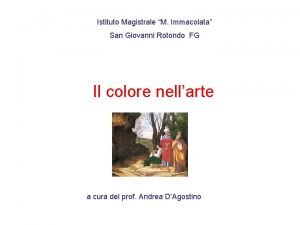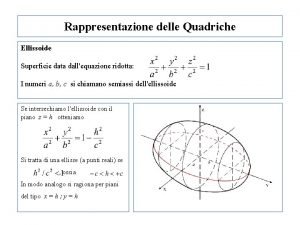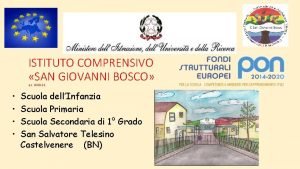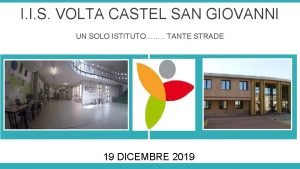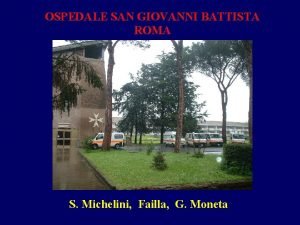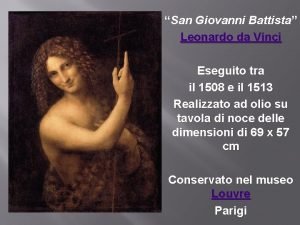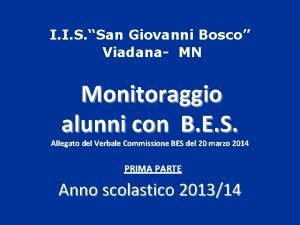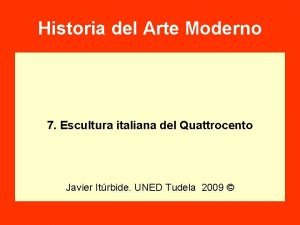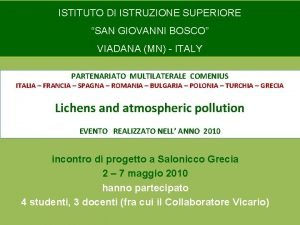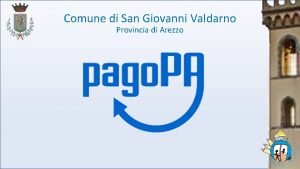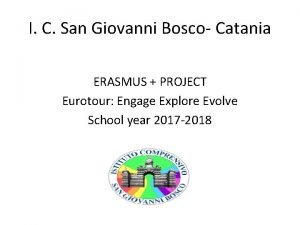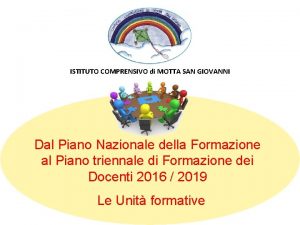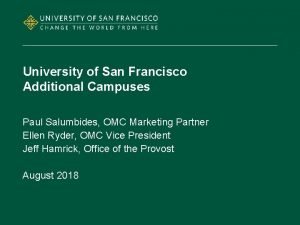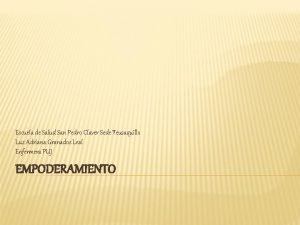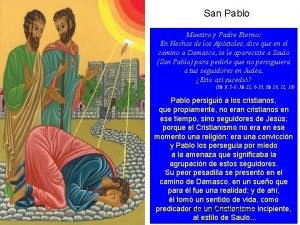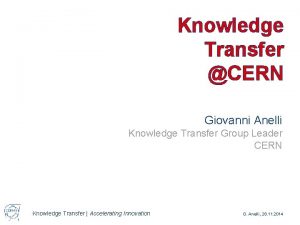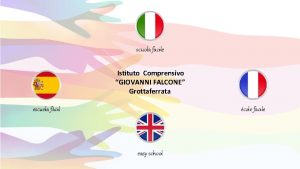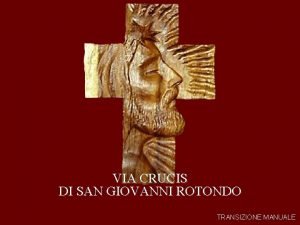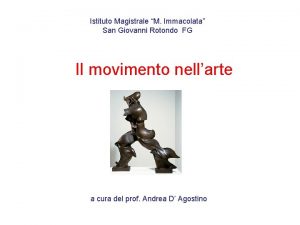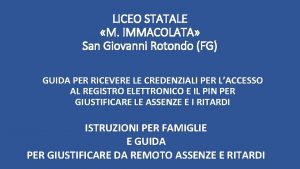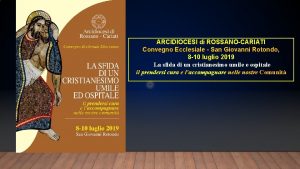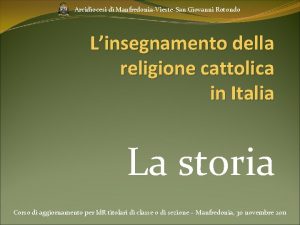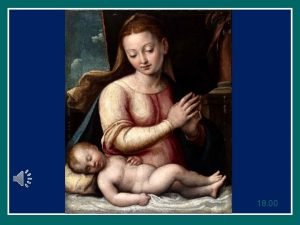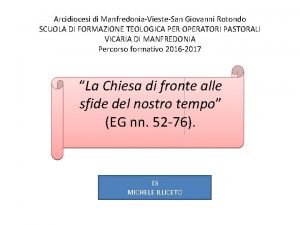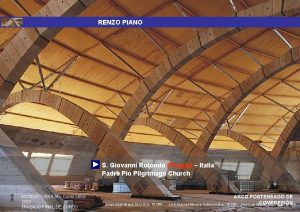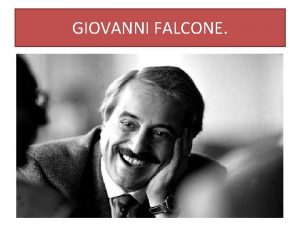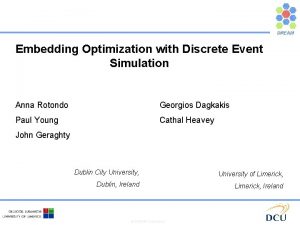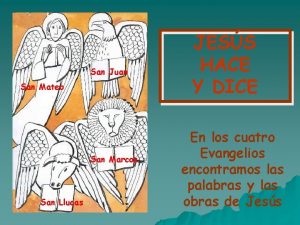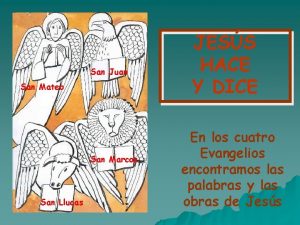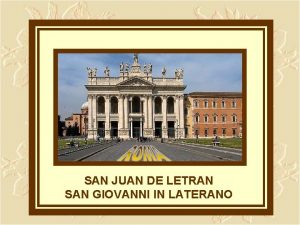SAN GIOVANNI ROTONDO SAN GIOVANNI ROTONDO San Giovanni


















- Slides: 18

SAN GIOVANNI ROTONDO

SAN GIOVANNI ROTONDO San Giovanni Rotondo is located among the mountains, near one of the paths leading to the Cave of the Archangel Michael. The first settlement dates back to the Neolithic Age; in the tenth century BC the area was occupied by the Dauni. Its history is linked to the domination Lombard, Byzantine and Norman. After a glorious brackets under Frederick II, the town known the dark periods of occupations Angevin and Aragonese. Padre Pio of Pietrelcina, who lived and worked here for 52 years, arrived in 1916 and redeemed the city from the abandonment of central governments and poverty in a stingy land. Since that time, the history of San Giovanni Rotondo bears the name of Padre Pio, who had the merit to renew the message of faith spreading it all over the Catholic world. The economy of San Giovanni Rotondo revolves around the figure of the saint. The town center is only marginally affected by the large influx of tourists due to the cult of Padre Pio, which is consumed almost exclusively around the area of the Convent.

THE CONVENTO OF SANTA MARIA DELLE GRAZIE The Convent of Santa Maria delle Grazie today is known throughout the world thanks to St. Pio of Pietrelcina, and from the convent of the Capuchins. Five century ago the church was given to the Capuchin Fathers by a man named Antonio Landi who owned a farm located on the north-west hill of San giovanni Rotondo. The Capuchins erected the walls of the church in 1540. Before St. Pius, the church hosted another holy in the cell n º 5 of the convent where St. Camillus de Lellis slept. The church was restored in the following years by Penati Natale.

THE CHURCH OF ST. NICHOLAS Walking through its streets you encounter others churches: the Church of St. Nicholas, characterized by a precious portal copper depicting the life of St. Nicholas: it was built in the sixteenth century. Inside the church you can see, in particular, the statue of "Our Lady of the Seven Sorrows" whose rare and heavenly beauty blends with the touching expression of grief for the death of Jesus

THE CHURCH OF ST. CATHERINE’S St. Catherine's Church (the oldest in the country): The church, formerly called Santa Maria Maggiore, dating back to 1176. Was only in the seventeenth century was dedicated to St. Catherine. Despite being the oldest church, does not retain its original appearance.

The MOTHER CHURCH OF SAN LEONARDO The Mother Church of San Leonardo ( the main church of San Giovanni Rotondo , on the entrance it presents a valuable statue of St. Michael the Archangel ): the Church of San Leonardo Abate is the church of San Giovanni Rotondo. Of its medieval genesis remains a little evidence since the second half of the seventeenth century the Archbishop of Manfredonia Vincenzo Maria Orsini , the future Pope Benedict XIII, decided to demolish it and invited the people to rebuild the church of San Giovanni at his own expense , ceasing to practice superstitious customs and traditions. The people of San Giovanni ignores the interdict and excommunication of Archbishop everyone. At this juncture it develops a mysterious disease that attacks the causes of San Giovanni and approximately 500 victims out of a population of 2690 people.

The CHURCH OF ST. URSULA The Church of St. Ursula ( very rich in history and recently restored ): built from the end of the sixteenth century , and almost entirely rebuilt between the seventeenth and eighteenth centuries. The monastery church of St. Ursula is located in the historic center of San Giovanni Rotondo and sacred building is the most rich in art and history. It is like the "Church of the Purgatory " , 8 December 1638 , the church is the seat of the Arch of the Dead. The confraternity later bought many houses around the church, to satisfy the desire of Verna ( priest of the time) , but failed to realize the monastery. Outside, the curved facade in rococo baroque style , is enhanced by the portal by breccia and windows and niches , where there are two stone statues of St. Francis of Assisi and St. Anthony of Padua. The interior, fully restored in recent years , contains several interesting paintings of the Neapolitan school , one of the holy bishops , that of the Madonna and Child, Saint Cajetan of Thiene and the Souls of Purgatory.

The CHURCH OF OUR LADY OF LORETO The Church of Our Lady of Loreto: the small church was built outside the city walls in the fifteenth century by pilgrims. The Sanctuary of Saint Michael the Archangel. The church reproduces the actual size of the birthplace of Jesus.

The CHURCH OF SANT’ONOFRIO The Church of Sant 'Onofrio: shrine of medieval origins, the Church of Sant 'Onofrio is inspired in its architectural essentiality, like the convent of Santa Maria and the values of charity of this town.

The CHURCH OF ST. JOHN THE BAPTIST It 's the oldest monument in the country, so as to give it the function of a pagan temple dedicated to the god Janus, according to legend. Some consolidation work carried out in 1995 under the plaster revealed a series of frescoes and paintings of - among others figures of monks, processions, madonnas. In 1999 it was discovered a baptismal font of the first centuries of the Middle Ages.

THE AREA OF SANT’EGIDIO The area of Sant'Egidio, with a very extensive lake, is surrounded by lush and vast forests that lent themselves well to the predatory activities (hunting and fishing). Here we have numerous archaeological finds relating to this period: stone tools, flint scrapers (denticulate, doors, fairings, to muzzle), chisels and other artifacts to splinter. The village was already frequented by Neolithic transhumance shepherds who went to a nearby lake to water their herds. Today, the Hamlet of Sant'Egidio is present in all three towers of the coat of arms of the town of San Giovanni Rotondo The white banner, whose rod is placed diagonally, is the symbol of the victory of the Redeemer on the forces of evil.

The OF SAN OLD TOWN GIOVANNI ROTONDO In the historical center the atmosphere is unique and magical. The weather here seems to have stopped. The kids still play in the street, while the elderly find themselves chatting in the doorways of the doors of houses that recall the old days so full of charm and simple life. The narrow streets are intertwined in a maze of alleys, there are ornamental plants on balconies and "mugnali" (external staircases) and many little details full of charm and history. Towers, palaces, ancient churches, monuments. Following a fascinating journey through narrow alleys and quaint, treading the ancient cobbled streets of local stone, you will relive the magic and the feeling of a medieval village!

The NEW CHURCH The "new church" was built in order to accommodate the large influx of thousands of pilgrims who flocked more and more in San Giovanni Rotondo. The church, designed by architect Giuseppe Gentile, was begun July 2, 1956 and was consecrated on July 1, 1959. The nave is dominated by a mosaic depicting the Madonna delle Grazie. On the floor below, there is the crypt where lies the body of St. Pio of Pietrelcina, under a monolith of 30 quintals. During the night between 2 and 3 March 2008 was re-opened the coffin containing the body of St. Pio. He is now exposed in a glass case and he has been venerating by faithfuls since 24 April 2008 until 23 September 2009.

PADRE PIO Padre Pio was born May 25, 1887 in Pietrelcina, Italy, a small country town located in southern Italy. Padre Pio entered the Capuchins at the age of 15. He was ordained on August 10 th of 1910. He was then assigned to Saint Giovanni Rotondo in 1916 and lived there until his death. He received the stigmatas on the 20 th of September of 1918 and had them for 50 years. He entered eternal life on the 23 rd of September of 1968, was beatified by Pope John Paul II on the 2 nd of May of 1999 and canonized by him on the 16 th of June of 2002. Padre Pio is one of the greatest mystics of our time, loved everywhere in the world. He taught us how to live a radical love for the heart of Jesus and for His Church. His life was prayer, sacrifice, and poverty. He attained a profound union with God A famous confessor, Padre Pio spent up to 16 hours daily in the confessional. Some had to wait up to two weeks to be able to go to confession with him because the Lord allowed them to see through this simple priest the truth of the Gospel. His life was centered on and revolved around the Eucharist. His Masses moved the hearts of the faithful due to his profound devotion which he attained through the Virgin Mary.

LA CASA SOLLIEVO DELLA SOFFERENZA La Casa Sollievo della Sofferenza in San Giovanni Rotondo is a health care facility and was inaugurated by Padre Pio May 5, 1956. “House for Relief and Suffering” is a religious hospital classified as highly specialized. The Hospital of St. Pio of Pietrelcina has about 900 beds divided among 30 medical and surgical wards, 50 clinical specialties with a "catalog" of about 4300 diagnostic and therapeutic services

The GARGANO "The Gargano is more diverse than you might imagine. He has in his heart the Umbra Forest with beeches and oaks that have a height of 50 meters and a trunk of an armful of 5 meters, and the age of Methuselah; with fir, maple, yew; with an exuberance, a color, the idea that the seasons will be enchanted by the hour in the evening; with deer, hares, foxes who run away from between his feet; with every warble, whine, chirping of birds. . . » cit. Giuseppe Ungaretti

THE GARGANO PROMONTORY The Gargano promontory is actually an island, divided from the peninsula by Tavoliere delle Puglie plateau. It is rich in karst structures like caves and dolines. While in the past the promontory was entirely covered with forests, now they represent only the 15% of its original surface area: the most important woodland in the Park is Foresta Umbra.

The End of SAN GIOVANNI ROTONDO
 Istituto maria immacolata san giovanni rotondo
Istituto maria immacolata san giovanni rotondo Ellissoide di rotazione
Ellissoide di rotazione I c san giovanni bosco
I c san giovanni bosco Liceo volta castel san giovanni
Liceo volta castel san giovanni Bendaggio a spina di pesce
Bendaggio a spina di pesce Giovanni battista leonardo da vinci
Giovanni battista leonardo da vinci Istituto don bosco viadana
Istituto don bosco viadana Pollaioulo
Pollaioulo San giovanni bosco viadana
San giovanni bosco viadana Suap azzano decimo
Suap azzano decimo Ic san giovanni bosco catania
Ic san giovanni bosco catania Istituto comprensivo motta san giovanni
Istituto comprensivo motta san giovanni Dsv spa verona
Dsv spa verona Usf sacramento
Usf sacramento Escuela de salud san pedro claver sede san antonio
Escuela de salud san pedro claver sede san antonio Qué opinas acerca de san pedro y san pablo
Qué opinas acerca de san pedro y san pablo Giovanni anelli
Giovanni anelli Rita bonnici prima moglie di falcone
Rita bonnici prima moglie di falcone Istituto giovanni falcone grottaferrata
Istituto giovanni falcone grottaferrata
